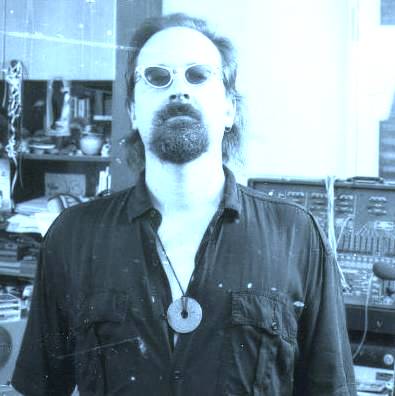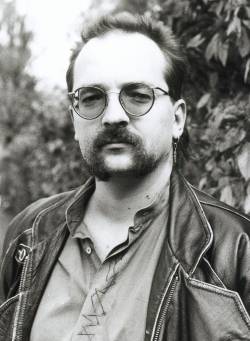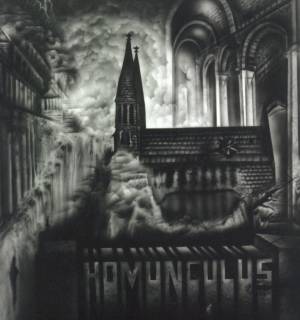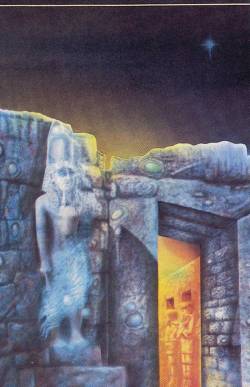THE ONEIRIC PROSPECTIONS OF
PETER FROHMADER
By: Jorge Munnshe
 Art is said to be multidisciplinary.
German artist Peter Frohmader appears to confirm this as he successfully works in two
terrains: Music and Painting. In both fields, his artistic creativity has always been
aimed at metaphysical, esoteric, cosmic concepts. As a composer, he has released about
twenty albums under labels from Germany, Sweden and the United States. He has made music
for television movies and documentaries, and composed soundtracks for some of the films by
Swiss videoartist and a fellow painter H.R. Giger, well known as the creator of the
background stage art in the film "Alien" who was awarded an Oscar. Precisely,
Giger has on occasion claimed that he would have liked Frohmader to have composed the
soundtrack for this movie. As a painter, his paintings are displayed at important
exhibitions of fantasy art, and he makes commercial illustrations, such as book and record
covers, postcards, and even posters; besides, of course, the covers for his own music
albums. He sometimes combines painting and music in his video productions.
Art is said to be multidisciplinary.
German artist Peter Frohmader appears to confirm this as he successfully works in two
terrains: Music and Painting. In both fields, his artistic creativity has always been
aimed at metaphysical, esoteric, cosmic concepts. As a composer, he has released about
twenty albums under labels from Germany, Sweden and the United States. He has made music
for television movies and documentaries, and composed soundtracks for some of the films by
Swiss videoartist and a fellow painter H.R. Giger, well known as the creator of the
background stage art in the film "Alien" who was awarded an Oscar. Precisely,
Giger has on occasion claimed that he would have liked Frohmader to have composed the
soundtrack for this movie. As a painter, his paintings are displayed at important
exhibitions of fantasy art, and he makes commercial illustrations, such as book and record
covers, postcards, and even posters; besides, of course, the covers for his own music
albums. He sometimes combines painting and music in his video productions.
Although he has fans in numerous countries, he continues to be one
of these characters who exist in the shadows, only known by few people. He is an honest
artist who has always preferred the integrity of his art to commercial success.
ARTISTIC TRAJECTORY AND IDENTITY
Peter Frohmader was born in the German city of Munich on May 9, 1958. His artistic
vocation is the first one in his family, who have never supported him. They don't like
what he does, and furthermore, they consider he earns little money. When he was a child,
he felt a great interest in producing all kinds of sounds with different objects. At about
age 11 or 12 he began to record his sound experiments on tape and manipulate the
recordings. Also from an early age interested in painting, he studied art and graphic
design, graduating in these. During his teenage years, and throughout the 1970s, he
founded several avantgarde or alternative music bands. At the end of this period, he
performed live in Germany and Austria, and contacted artists from other countries. In 1979
he started to record what would become his first solo LP album. The LP, called
"Nekropolis", appeared in 1981. Since then, his cadence in album releases has
been more or less annual. These are in actual fact sonic-visual works, as he paints one or
several paintings for each album.
 His musical compositions have been
said to be the musical shaping of the artistic works by Giger, specially those used for
"Alien", what proves the understanding between both artists and why Giger
considers Frohmader to be the perfect composer for the soundtrack for "Alien".
Yet apart from this affinity, the compositions created by Frohmader are, above all, the
musical equivalent to his paintings, and not only the ones published as the covers for his
albums. Thus for example, his first album, "Nekropolis", is a symphony divided
into two cycles, the one of the Night and the one of Hell, which contains references to
the devils in the Tibetan paintings. In two pieces of "Nekropolis Live", texts
extracted from the novel by Lovecraft "On the Mountains of Madness" are recited,
together with a poem by Gottfried Benn about a corpse. His series "Homunculus",
which he has been publishing in Sweden, is a clear connection with his paintings of evil
medieval atmospheres. Or the symphonies "Plague Dances" and "Malleus
Maleficarum", from his double LP "Through Time & Mystery - Ending". At
the same time, his concerts at cathedrals, both for the music and the place, reflect these
mystic-baroque traits.
His musical compositions have been
said to be the musical shaping of the artistic works by Giger, specially those used for
"Alien", what proves the understanding between both artists and why Giger
considers Frohmader to be the perfect composer for the soundtrack for "Alien".
Yet apart from this affinity, the compositions created by Frohmader are, above all, the
musical equivalent to his paintings, and not only the ones published as the covers for his
albums. Thus for example, his first album, "Nekropolis", is a symphony divided
into two cycles, the one of the Night and the one of Hell, which contains references to
the devils in the Tibetan paintings. In two pieces of "Nekropolis Live", texts
extracted from the novel by Lovecraft "On the Mountains of Madness" are recited,
together with a poem by Gottfried Benn about a corpse. His series "Homunculus",
which he has been publishing in Sweden, is a clear connection with his paintings of evil
medieval atmospheres. Or the symphonies "Plague Dances" and "Malleus
Maleficarum", from his double LP "Through Time & Mystery - Ending". At
the same time, his concerts at cathedrals, both for the music and the place, reflect these
mystic-baroque traits.
One of the first things that attracts the attention most in his
paintings, is the use he makes of black and white to enhance certain themes or elements.
Thus for instance, his landscapes of narrow medieval streets look like pictures extracted
from accursed books, and his ghostly Gothic cathedrals have an undeniably evil aura.
Looking at some of those black and white elements, as for example the entire series of
"Homunculus", it must be admitted that in full color they would not be so very
impressive. He also incorporates this technique into photography and even to his own
person, and decides he is one of these elements that must appear in black and white.
Therefore, he always prefers photos to show him in black and white, instead of color.
 Some of his illustrations, as for
instance the mass of human remains that presides the cover of his first album, or the
poster that is included in his second album, show his vincle to death and Beyond. He sees
these universal enigmas as a key for his creativity.
Some of his illustrations, as for
instance the mass of human remains that presides the cover of his first album, or the
poster that is included in his second album, show his vincle to death and Beyond. He sees
these universal enigmas as a key for his creativity.
In a great part of his paintings there reigns a nocturnal
atmosphere, perhaps enhanced by the timetable of his artistic work; Frohmader has produced
his works mostly at night, at least in the past. And an oneiric texture, nightmarish in
nature, pervades these paintings as well, so as to try harvest some of the essence of bad
dreams, by means of atavistic, ancestral signs, from terror. The final effect is to
reflect the things that each observer of the painting would swear to have dreamed in some
nocturnal nightmare.
Nevertheless, his work is not as dark as many people believe, and
this is an important point. Frohmader has become famous as an "accursed artist"
because the most remarkable part of his art is the sinister content, and therefore, this
is what is more popularized. In his music there also are passages of light and beauty, a
sincere message as opposed to the commercial productions that have appropriated the term
"New Age".
In his paintings, he shapes cosmic adventures where the observer can
contemplate lakes and rocks made from light, the origin of life fused with the birth and
death of suns, exuberant jungles spreading to the horizon, intergalactic starscapes swept
by the cold light of nebulae, or simply the Sun rising from the clouds and shedding its
light after a storm.
Up to a certain point, the dark and light aspects of Frohmader's art
have a chronological distribution throughout his career. And thus we have that in the
first years darkness, the macabre, the evil dominate; while in his latter years it is
light, beauty, the cosmic, what takes the place of the former. Although in the mid 1980s,
with "The Jules Verne Cycle" (two pieces based on two stories by Verne:
"The Mysterious Island" and "20,000 Leagues Under the Sea"), this
subtle change can already be appreciated, it isn't until 1988 with "Spheres",
when Frohmader leaves the dark regions and makes a cosmic voyage towards the worlds of
light. This new artistic and aesthetic concept continues in the CD "Miniatures"
(1989), whose cover is a painting on the wave of the German futuristic trends of the 1920s
- 1930s; as well as in 1990, in the CD "Macrocosm" (released in the United
States). The final jump arrives with "3rd Millenium's Choice Vol.1", which
closes the circle, and which in a way means a return to the original starting point, even
though from a different angle. By the end of 1990, he engages on a trip to the French
Brittany, so as to find artistic inspiration and produce a 20 minute film showing
landscapes and impressions in his personal style, including music. This music is included
in his CD "Armorika", running time 74 minutes, released at the beginning of
1991. The result is a very dense, imaginative work, specially in the themes
"Tumulus", "Les Roches du Diable", and "Dolmen". At the
beginning of 1992, his CD "3rd Millennium's Choice Vol.2" is released, a
meditative excursion that enters science-fiction rather than terror. Later, new, excellent
works appear.
 COLLABORATIONS, CONTACTS AND
INFLUENCES
COLLABORATIONS, CONTACTS AND
INFLUENCES
The relationship between H.R. Giger and Frohmader began when Giger heard music by
Frohmader. He felt fascinated and proposed him to make the soundtrack for one of his
videos. Frohmader accepted, and from this point a productive relationship between them
both developed. Giger claims that he usually paints listening to Frohmader's music. On the
other hand, Frohmader admits that he has been influenced in his paintings by Giger.
He is a good friend of Florian Fricke, the alma mater of the mystic
music band Popol Vuh, known for their cosmic music since the early 1970s, as well as their
movie soundtracks for German movie -maker Werner Herzog at an international level.
Musically speaking, he has collaborated with Ax Genrich from
Guru-Guru, and Christoph Karrer from Amon Düül-2, members from two legendary bands of
German psychedelic music, predecessors to the New Age movement. In his recordings
sometimes collaborate violinists Stephan Manus and Iva Bittová, Stephan Seithel
(Oboe), Birgit Metzger (vocals), and others. Through Nekropolis Records, his record label,
he has produced CDs from other interesting alternative musicians, as for instance Andreas
Merz and Gerd Schedel (two electronic experimental composers from Munich), and Gulaab.
He has worked with the painters of contemporary fantasy art Ernst
Fuchs and Hellmut Neukircht; and he has been in contact with sculptor Martin Schöneich as
well as painters Wolfgang Ohlhäuser and Elke Wassmann.
Among his influences we find the Gothic horror movies from silent
movies, as for instance the "Nosferatu" by Murnau, besides the metaphysical
science-fiction movies from Russia and Poland, among them "Solaris" and
"Stalker". As for the writers who have influenced him most, these are: H.P.
Lovecraft (whom he has illustrated), Edgar Allan Poe, Clark Ashton Smith, Henry James,
Bram Stoker, Algernon Blackwood, among less known ones. Besides Giger, the painters who
have influenced him most are Bosch and Grünewald.
 METAPHYSICAL INTERESTS
METAPHYSICAL INTERESTS
In my contacts with him, I have been able to ask him about the themes he bases his art on.
He believes in a life after death. In his opinion, when one
reaches it, the "ghosts", "spirits", or whatever way one
chooses to call them, have little influence on the physical universe inhabited by the
living people; they can only produce some noises and the like. The phenomenon of
poltergeists would be the most extreme form of such influence.
About the duality between Good and Evil, his philosophy is to live
doing good, following the laws of the positive. His concept of God is the creative power
of the universe. He dislikes the people who follow the philosophy of black magic. He
admits that mysticism is deep inside him "since I have been able to reason, since I
have been able to feel and think, since my childhood". And he adds: "I hope I
will reach higher evolutive levels after my death, what we could call "heaven"
or "paradise"."
He believes in the existence of extraterrestrial intelligent life,
even if he adds he has never seen a UFO. He considers that the biological shaping of such
beings can be very different from what we can imagine. In answer to my question about what
era, past, present or future, he would choose if he were born again, he replies that
"Perhaps there is no future time, due to the increasing destruction of the entire
planetary ecosystem."
About his relationship with dreams, he claims: "I dream
paintings, yet I don't usually paint them. What I paint are day dreams, if you wish to
call them so, day dreams in my fantasy. Nightmares are very interesting and with great
strength, artistically speaking. However, I don't so often paint such things, at least for
now. Some ten years ago, I did. Lately I am working in other themes, basically what we
could call "Magic Realism", whereas at a technical level now I work a lot with
light effects. Science-fiction has always been a theme for my art, both in my music and in
my paintings, and I have sometimes fusioned it with historical elements belonging to past
eras of humanity, as a general rule the Middle Ages, the also called Dark
Age"."
More information about Peter Frohmader at:
Official webpage:
http://www.dbeau-arts.de/Nekropolis/
Webpage in Amazing Sounds:
http://www.amazings.com/industry/nekrop.html
If you wish to purchase any recordings by him you only have to use
these links:
http://www.amazon.com/exec/obidos/ts/artist-glance/thesciencebookbo
Peter Frohmader & Richard Pinhas:
http://www.amazon.com/exec/obidos/ASIN/B00001ZSVY/thesciencebookbo
Multimood Records Sampler:
http://www.amazon.com/exec/obidos/ASIN/B000005A41/thesciencebookbo

 Previous Page (Articles/News)
Previous Page (Articles/News)
 Art is said to be multidisciplinary.
German artist Peter Frohmader appears to confirm this as he successfully works in two
terrains: Music and Painting. In both fields, his artistic creativity has always been
aimed at metaphysical, esoteric, cosmic concepts. As a composer, he has released about
twenty albums under labels from Germany, Sweden and the United States. He has made music
for television movies and documentaries, and composed soundtracks for some of the films by
Swiss videoartist and a fellow painter H.R. Giger, well known as the creator of the
background stage art in the film "Alien" who was awarded an Oscar. Precisely,
Giger has on occasion claimed that he would have liked Frohmader to have composed the
soundtrack for this movie. As a painter, his paintings are displayed at important
exhibitions of fantasy art, and he makes commercial illustrations, such as book and record
covers, postcards, and even posters; besides, of course, the covers for his own music
albums. He sometimes combines painting and music in his video productions.
Art is said to be multidisciplinary.
German artist Peter Frohmader appears to confirm this as he successfully works in two
terrains: Music and Painting. In both fields, his artistic creativity has always been
aimed at metaphysical, esoteric, cosmic concepts. As a composer, he has released about
twenty albums under labels from Germany, Sweden and the United States. He has made music
for television movies and documentaries, and composed soundtracks for some of the films by
Swiss videoartist and a fellow painter H.R. Giger, well known as the creator of the
background stage art in the film "Alien" who was awarded an Oscar. Precisely,
Giger has on occasion claimed that he would have liked Frohmader to have composed the
soundtrack for this movie. As a painter, his paintings are displayed at important
exhibitions of fantasy art, and he makes commercial illustrations, such as book and record
covers, postcards, and even posters; besides, of course, the covers for his own music
albums. He sometimes combines painting and music in his video productions. His musical compositions have been
said to be the musical shaping of the artistic works by Giger, specially those used for
"Alien", what proves the understanding between both artists and why Giger
considers Frohmader to be the perfect composer for the soundtrack for "Alien".
Yet apart from this affinity, the compositions created by Frohmader are, above all, the
musical equivalent to his paintings, and not only the ones published as the covers for his
albums. Thus for example, his first album, "Nekropolis", is a symphony divided
into two cycles, the one of the Night and the one of Hell, which contains references to
the devils in the Tibetan paintings. In two pieces of "Nekropolis Live", texts
extracted from the novel by Lovecraft "On the Mountains of Madness" are recited,
together with a poem by Gottfried Benn about a corpse. His series "Homunculus",
which he has been publishing in Sweden, is a clear connection with his paintings of evil
medieval atmospheres. Or the symphonies "Plague Dances" and "Malleus
Maleficarum", from his double LP "Through Time & Mystery - Ending". At
the same time, his concerts at cathedrals, both for the music and the place, reflect these
mystic-baroque traits.
His musical compositions have been
said to be the musical shaping of the artistic works by Giger, specially those used for
"Alien", what proves the understanding between both artists and why Giger
considers Frohmader to be the perfect composer for the soundtrack for "Alien".
Yet apart from this affinity, the compositions created by Frohmader are, above all, the
musical equivalent to his paintings, and not only the ones published as the covers for his
albums. Thus for example, his first album, "Nekropolis", is a symphony divided
into two cycles, the one of the Night and the one of Hell, which contains references to
the devils in the Tibetan paintings. In two pieces of "Nekropolis Live", texts
extracted from the novel by Lovecraft "On the Mountains of Madness" are recited,
together with a poem by Gottfried Benn about a corpse. His series "Homunculus",
which he has been publishing in Sweden, is a clear connection with his paintings of evil
medieval atmospheres. Or the symphonies "Plague Dances" and "Malleus
Maleficarum", from his double LP "Through Time & Mystery - Ending". At
the same time, his concerts at cathedrals, both for the music and the place, reflect these
mystic-baroque traits. Some of his illustrations, as for
instance the mass of human remains that presides the cover of his first album, or the
poster that is included in his second album, show his vincle to death and Beyond. He sees
these universal enigmas as a key for his creativity.
Some of his illustrations, as for
instance the mass of human remains that presides the cover of his first album, or the
poster that is included in his second album, show his vincle to death and Beyond. He sees
these universal enigmas as a key for his creativity. COLLABORATIONS, CONTACTS AND
INFLUENCES
COLLABORATIONS, CONTACTS AND
INFLUENCES METAPHYSICAL INTERESTS
METAPHYSICAL INTERESTS